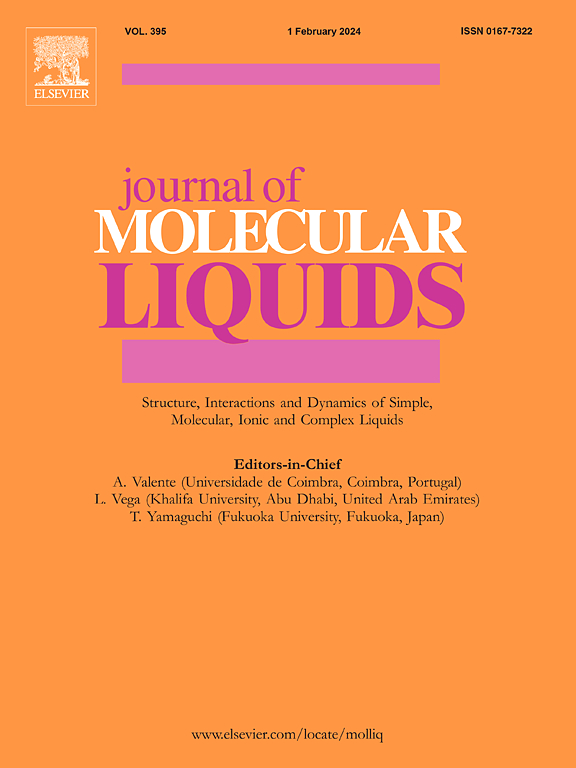Microstructures and molecular interactions of a double salt ionic liquid system: 1-Butyl-3-methylimidazolium tetrafluoroborate + N,N-diethyl-2-methoxy-N-methylethanaminium bis(trifluoromethylsulfonyl)imide
IF 5.3
2区 化学
Q2 CHEMISTRY, PHYSICAL
引用次数: 0
Abstract
The double salt ionic liquids (DSILs) are garnering increasing attention due to their unique properties. DSILs are not simple mixtures of two ionic liquids, and each DSIL possesses distinct characteristics. Despite their potential, the molecular interactions within DSILs remain underexplored, highlighting the need for further investigation to enrich foundational knowledge and foster new methodologies and applications. This work studied the structures and molecular interactions of 1-butyl-3-methylimidazolium tetrafluoroborate (BMIMBF4) and N,N-diethyl-2-methoxy-N-methylethanaminium bis(trifluoromethylsulfonyl)imide (DEMETFSI) DSILs through spectroscopic and theoretical methods. The cis- and trans-configurations of [TFSI]− were analyzed by Raman spectroscopy. Detailed vibrational analyses in the region of v(imidazolium ring C–H) and the region of v(S=O) were performed. Interaction complexes between BMIMBF4 and DEMETFSI were identified using excess infrared spectroscopy, and quantum chemical calculations were performed to investigate these complexes. The possible interactions between the complexes in the DSILs were determined and the changes in the interactions were revealed.
求助全文
约1分钟内获得全文
求助全文
来源期刊

Journal of Molecular Liquids
化学-物理:原子、分子和化学物理
CiteScore
10.30
自引率
16.70%
发文量
2597
审稿时长
78 days
期刊介绍:
The journal includes papers in the following areas:
– Simple organic liquids and mixtures
– Ionic liquids
– Surfactant solutions (including micelles and vesicles) and liquid interfaces
– Colloidal solutions and nanoparticles
– Thermotropic and lyotropic liquid crystals
– Ferrofluids
– Water, aqueous solutions and other hydrogen-bonded liquids
– Lubricants, polymer solutions and melts
– Molten metals and salts
– Phase transitions and critical phenomena in liquids and confined fluids
– Self assembly in complex liquids.– Biomolecules in solution
The emphasis is on the molecular (or microscopic) understanding of particular liquids or liquid systems, especially concerning structure, dynamics and intermolecular forces. The experimental techniques used may include:
– Conventional spectroscopy (mid-IR and far-IR, Raman, NMR, etc.)
– Non-linear optics and time resolved spectroscopy (psec, fsec, asec, ISRS, etc.)
– Light scattering (Rayleigh, Brillouin, PCS, etc.)
– Dielectric relaxation
– X-ray and neutron scattering and diffraction.
Experimental studies, computer simulations (MD or MC) and analytical theory will be considered for publication; papers just reporting experimental results that do not contribute to the understanding of the fundamentals of molecular and ionic liquids will not be accepted. Only papers of a non-routine nature and advancing the field will be considered for publication.
 求助内容:
求助内容: 应助结果提醒方式:
应助结果提醒方式:


